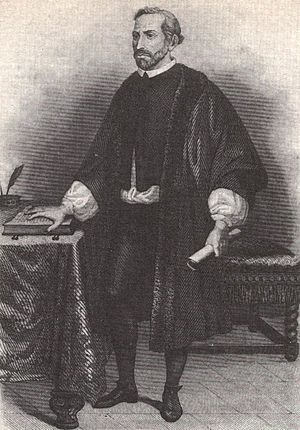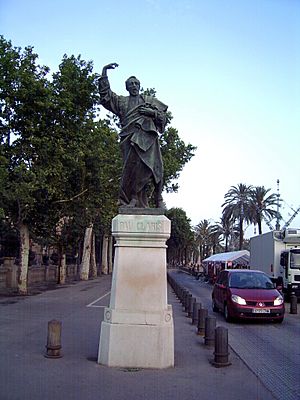Pau Claris i Casademunt facts for kids
Quick facts for kids
Pau Claris i Casademunt
|
|
|---|---|
 |
|
| 94th President of the Deputation of the General of Catalonia | |
| In office 22 July 1638 – 26 January 1641 |
|
| Preceded by | Miquel d'Alentorn i de Salbà |
| Succeeded by | Josep Soler |
| 1st President of the Catalan Republic | |
| In office 17 January 1641 – 23 January 1641 |
|
| Succeeded by | Baldomer Lostau In 1873 |
| Personal details | |
| Born | 1 January 1586 Barcelona |
| Died | 27 February 1641 (aged 55) Barcelona |
| Political party | None |
Pau Claris i Casademunt (born January 1, 1586 – died February 27, 1641) was an important Catalan leader. He was a lawyer and a clergyman, which means he worked with the church. He became the 94th President of the Generalitat of Catalonia. This was the government of Catalonia at the time. He led Catalonia during a big conflict called the Catalan Revolt. On January 16, 1641, he declared Catalonia a republic, which meant it would be an independent country, with help from France.
Contents
Pau Claris's Life Story
Early Years and Education
Pau Claris was born in Barcelona, a city in what was then called the Principality of Catalonia. At that time, Catalonia was part of the Spanish Monarchy. His family came from a town called Berga. Both his grandfather and father were important jurists in Barcelona. A jurist is someone who studies and practices law.
Pau was the youngest of four brothers. His older brother, Francesc, was also a lawyer and helped guide Pau towards a life in politics. The Claris family was part of the "bourgeois," which means they were a wealthy and powerful middle-class family in Barcelona. They had a lot of influence in business and government.
Pau Claris studied at the University of Barcelona. He earned a special degree in both civil law and canon law. Civil law deals with private relationships between people, like contracts. Canon law is the set of rules and laws made by the Christian Church. He studied these subjects between 1604 and 1612.
In 1612, Pau Claris started working in La Seu d'Urgell, a city where the Bishop of Urgell lived. Soon after, he became a "canon," which is a type of priest who works in a cathedral. He was assigned to the Diocese of Urgell, which is an area managed by a bishop.
Starting a Political Career
In 1626, Pau Claris was chosen to represent the church in the Corts Catalanes, also known as the Parliament of Catalonia. This meeting began on March 28. It was a difficult time politically because the new king of Spain, Philip IV, refused to approve Catalonia's laws, called the Catalan constitutions. The king wanted more taxes, and there were arguments about whether royal officers had to follow Catalan law.
The Catalan church was tired of paying high royal taxes. They also didn't like that the king often chose bishops from Castile (another part of Spain) to lead churches in Catalonia. The Catalans refused to pay a large tax of 3,300,000 ducats (an old type of money). Because of this, the king quickly left for Madrid.
The Parliament didn't meet again until 1632, with the same members. By this time, many Catalans were openly rebelling against the Spanish king. A group of smart lawyers, like Joan Pere Fontanella, led this movement. Fontanella advised both the Generalitat (the Catalan government) and the Consell de Cent (Barcelona's city government).
In 1632, Claris was chosen by the church's part of the government to handle an election. On July 15, a group of eighteen people, called the Divuitena, were appointed to form the Executive Board.
One important event during Claris's early political life was the riots in Vic. The king of Spain was given permission by the Pope to collect a tenth of the church's income in Spain. This made people very angry, especially in the diocese of Vic. Local leaders, including Claris and another canon from Urgell, supported the protests.
The Royal Court tried to take church property in Vic, which led to protests and threats of rebellion in 1634. Even though there was pressure from the bishop of Girona, only one deacon was arrested. The conflict delayed the tax payment until the end of November.
Claris also attended church meetings in Tarragona in 1630 and 1636. In 1636, he helped pass a rule that all sermons in Catalonia had to be in the Catalan language. This was a big step, even though the Spanish archbishop of Tarragona tried to stop it.
Leading the Generalitat
On July 22, 1638, Pau Claris was elected as the church's representative for the Diputació del General, which is another name for the Generalitat. As the church deputy, Claris led the meetings of the Generalitat. The Spanish Viceroy of Catalonia, Dalmau de Queralt, tried to bribe Claris and another deputy, Francesc de Tamarit, but failed.
Claris took over a government with serious money problems. This was due to years of poor management and conflicts with the Spanish Crown. The Crown accused the Generalitat of smuggling because Catalonia was trading with France, even though it was forbidden due to the Thirty Years' War.
When a sheriff, sent by the Viceroy, seized goods in Mataró and Salses, it started a big conflict. The lawyer Joan Pere Fontanella again played a key role, supporting the Generalitat. Barcelona eventually sided with the Generalitat, especially after the Crown decided to demand an extra 50,000 pounds from Catalonia each year for 1639 and 1640.
King Philip IV and his chief minister, the Count-Duke of of Olivares, wanted all parts of Spain to help pay for the Thirty Years' War. This war had already cost Castile a lot of money. Catalonia didn't feel like this war was their problem. Olivares wanted to open a new war front against France from Catalonia, with Catalan help.
In July 1639, the French army attacked and took the Fort de Salses in Roussillon. This led to a tough fight between the Count-Duke and the Generalitat to get Catalonia to do more in the war. Finally, the deputies agreed to send Francesc de Tamarit to lead new soldiers to get back the castle of Salses. They succeeded on January 6, 1640. However, the cost in lives and money for Catalonia was so huge that the situation became very tense.
The Catalan Revolt Begins
It's not clear exactly when talks with France began, but they eventually led to an alliance between Catalonia and France. This alliance would fight against the Spanish Crown and start the Reapers' War, also known as the Catalan Revolt. Historians still debate the exact timing, but it seems talks might have started as early as May 1640. Pau Claris called a general meeting on September 10, 1640. At the same time, without telling the cities, he started talking with the French.
On September 7, 1640, representatives from Catalonia signed the first Pact of Céret with a French delegate. This agreement meant that France would provide military support to Catalonia to fight against the Spanish army. Many believe that because of the strong Spanish military pressure, Claris felt pushed to accept France's offer. This would mean Catalonia would break away from the Spanish Monarchy and become a Free Republic protected by the French king.
From September 1640, Claris and his team seemed to take complete control. A special meeting called the Board of Arms (Junta General de Braços) was called. It became the main governing body for this new situation. The agreements with France and the separation from Spain were made official. Money was also raised to pay for military costs.
On October 20, 1640, the French delegate came to Barcelona. A few days later, France and Catalonia signed their first agreement for friendship and military help. France promised to defend Catalonia.
The Short-Lived Catalan Republic
On November 24, the Spanish army, led by the Marquis of Los Vélez, invaded Catalonia from the south. On December 23, Pau Claris declared war against Philip IV of Spain. The Spanish troops were winning battles in places like Tortosa, Cambrils, Tarragona, and Martorell. This forced the Board of Arms and the Consell de Cent to agree to France's demands. On January 16 and 17, they accepted the idea of making Catalonia a republic under France's protection.
But the Spanish army kept getting closer to Barcelona. Also, France had its own plans for Catalonia. This made Claris change the republican plan. On January 23, 1641, he declared Louis XIII of France to be the Count of Barcelona. This meant Catalonia would be ruled by the French king. This happened just three days before the Battle of Montjuïc. In this battle, the French and Catalan armies defeated the Spanish forces and stopped their attack on Barcelona.
Pau Claris's Death
On February 20, 1641, Pau Claris became very sick. This was the same day that a French commander arrived in Barcelona to lead all French and Catalan armies. The next day, Claris received his last religious rites. He died on the night of February 27. Even though he had been having health problems for about a year, people immediately thought he might have been poisoned. Some modern studies also support this idea.
Claris was buried in his family's tomb in the chapel of the Holy Christ, located in the Church of Sant Joan de Jerusalem in Barcelona. Sadly, this church was torn down in 1888 during a city renovation project for the Universal Exhibition of Barcelona.
Monuments and Honors
Several monuments have been built in Barcelona to honor Pau Claris. The most famous one is a statue at the end of the Passeig de Lluís Companys. This statue was made by Rafael Atché i Ferré and was first shown in 1917. It was taken down and kept safe during the Spanish Civil War and put back up in 1977. Since its dedication, this spot has become a place where people who support Catalan independence gather and remember important events.
In Barcelona, there is also a street named Carrer de Pau Claris in the Eixample district. It runs from Avinguda Diagonal to Plaça Urquinaona. Many other towns in Catalonia also have streets and squares named after him to show their respect. There is even a school named after him on the Passeig de Lluís Companys in Barcelona.
In the same year that Pau Claris died, a writer named Francesc Fontanella published a tribute to him called Panegíric a La Mort De Pau Claris De Francesc Fontanella.
See also
 In Spanish: Pau Claris para niños
In Spanish: Pau Claris para niños


